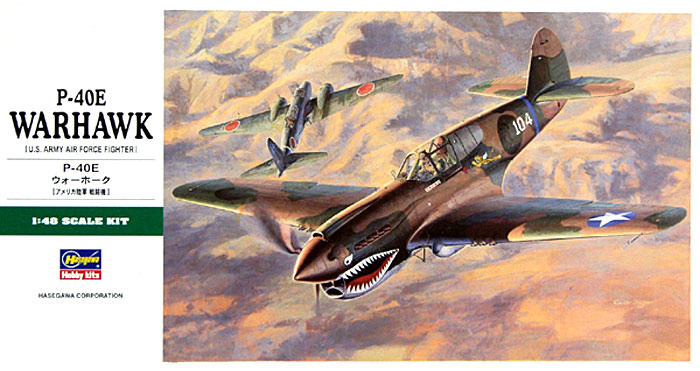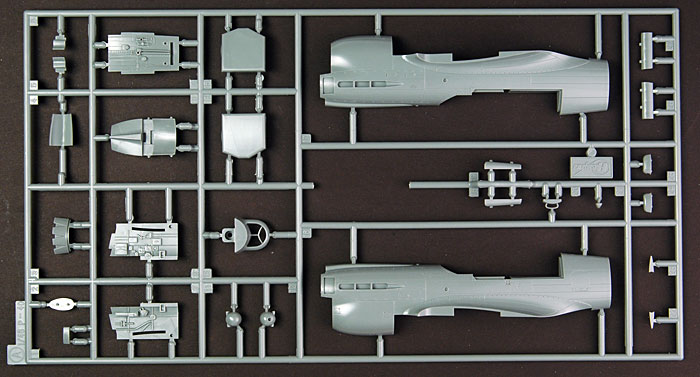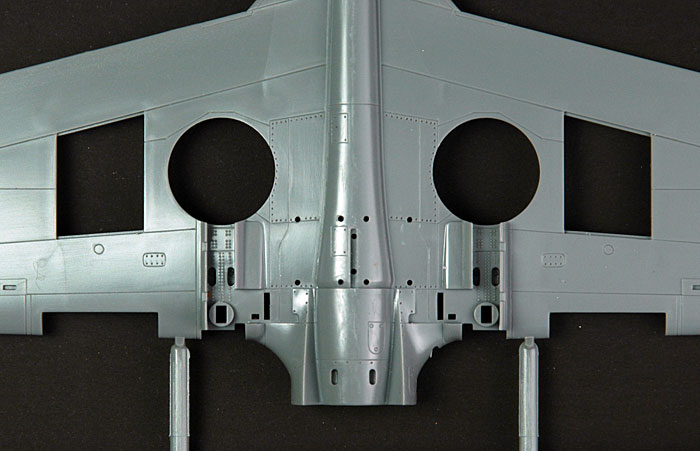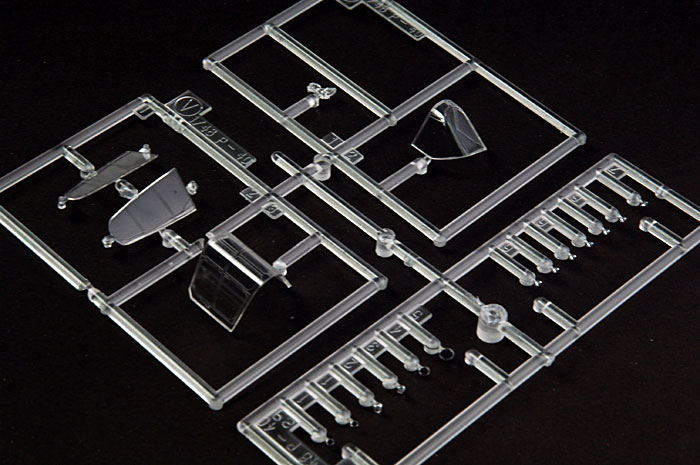|
Curtiss P-40E Warhawk

Hasegawa, 1/48 scale
S u m m a r y
|
| Catalogue
Number: |
JT86 - P-40E Warhawk |
| Scale: |
1/48 |
| Contents and Media: |
113 parts in grey styrene;
18 parts in
clear. |
| Price: |
USD$26.96 available online from Squadron |
| Review Type: |
FirstLook |
| Advantages: |
Excellent surface
texture; high level of detail including several P-40 attributes not
depicted on other kits; very good cockpit; accurate; optional bomb,
drop tank and wheel hubs; hollow machine gun muzzles; thin and
clear transparencies; two-part canopy. |
| Disadvantages: |
Gratuitous use of inserts to
maximize variants from one set of moulds; inserts do not fall on
natural panel lines (filling and sanding will be essential); some sink marks
and moulding marks may be visible on outside surfaces; all grey
parts packed into a single bag - some scuffing as a result |
| Recommendation: |
Highly Recommended |
Reviewed by Brett Green

Hasegawa's 1/48 scale P-40E Warhawk is available online from Squadron
P-40 fanciers have been fairly well treated in the last 10 years or
so.
In the mid 1990s, both Mauve and AMT released a series of 1/48 scale
Warhawks and Kittyhawks. All these models were accurate in outline,
featured finely recessed panel lines and were fairly well detailed. The
Mauve kit was superior in terms of surface detail; while AMT offered a
better cockpit. Mauve released the P-40M and P-40N, plus their RAF
equivalents (Kittyhawk III and IV); with the P-40F, K and N coming from
AMT.
Around the same time, Revell updated their 1970s vintage 1/48 scale
P-40E with a new cockpit, undercarriage and detail parts. Although it is
an older model with raised panel lines, I like the way this kit captures
the rugged character of the real aircraft.
New player AMtech entered the market at the turn of the century to
offer a number of previously unreleased variants based on the AMT kits.
These were the P-40E, plus short and long tailed versions of the P-40F
and P-40L. The Merlin powered variants were enhanced with a solid
replacement nose. This new nose was much more accurate than AMT's
forward fuselage. Eduard also got into the act, repackaging Mauve's
P-40M and N kits with new markings plus resin and photo-etched detail
parts.
All these 1/48 scale P-40s are quite acceptable and may be further
improved with after-market parts, but none of the kits are quite up to
the standard of the best models of other aircraft subjects available
today.
It would seem that Hasegawa has now set a new benchmark for P-40
kits.
Hasegawa's brand-new 1/48 scale P-40E Warhawk comprises 113 parts in
grey styrene, 18 parts in clear and four polythene caps.

Click the thumbnails below
to view larger images:
Surface detail is by way of crisply engraved panel lines supplemented
with selected rows of recessed rivets (notably on the wing root fairing,
the wing tips and trim tabs), some raised rivets (behind the rear
quarter windows) and raised fabric detail on control surfaces. The
combined effect of these surface features is outstanding - the equal to
some of Hasegawa's best work in this area to date.

The best detailed Hasegawa cockpits have generally been Japanese
subjects, but the new P-40E is an exception. This is one of Hasegawa's
finest front offices. The instrument panel, seat and rear bulkhead are
especially worthy of mention. Sidewall detail is also very good,
although slightly shallow. I was particularly pleased to see the oft
neglected canopy rails moulded to the cockpit opening.
Click the thumbnails below
to view larger images:
The kit supplies the separate underwing gun camera fairing, lower
fuselage fuel dump, the fin attachment plate for the aerial wire, spine
navigation light, a mirror for the windscreen plus a ring and bead
gunsight - all evidence of Hasegawa's careful attention to detail. Extra
effort has also been applied to the design of the pitot tube.
The tubular exhausts are supplied in sections of two stubs each,
which are simply glued on from the outside. Some P-40Es may have been
retrofitted with the later fishtail exhausts (not supplied), so check
your references carefully. The muzzles for the six .50 calibre machine
guns are hollowed out - a nice touch.
Lower cowl flaps are moulded in the open position, and incorporate
two tiny actuators. The radiator assembly includes rear face detail
which will be visible beyond the open flaps.
The rudder is a separate part.
The undercarriage legs and wheels are very well done, but the wheel
wells do not have the characteristic lightening holes in the spars.
Optional wheel hubs are supplied - spoked and covered.
Navigation and formation lights are moulded onto the grey plastic,
but alternative clear parts are supplied if the modeller prefers. If
this option is chosen, the moulded lights will have to be carefully
sliced off the fin and wings, and replaced with the tiny clear parts.
The canopy is supplied in four thin, distortion free parts.

Apart from the optional wheel hubs, the kit also offers a drop tank,
a 500lb bomb (both with their specific mounts and sway braces), two
styles of antenna mast, a DF loop and a DF football.
Kit engineering is the only wrinkle in the ointment. Hasegawa clearly
wants to release a large number of Warhawk/Kittyhawk variants, but they
also want to maximize the use of a single set of moulds. They have
achieved both of these objectives by the use of inserts. The kit
fuselage, in particular, is broken up according to the features of other
variants. For example, this P-40E kit has a blank rectangular insert on
each side the forward fuselage to allow for a vent in the same position
on P-40M and N aircraft. There is a large insert for the mid upper
fuselage to permit a later release with the arched perspex rear canopy
section. The entire tail is a separate sub-assembly to so that the
filleted fin of late P-40Es and the P-40K may be offered in future.
Similarly, each set of three wing machine guns are plugged into the
front of the wing's leading edge.
Now, this is good news for later variants, but it does potentially
compromise fit and complicate construction. The biggest complaint is
that none of these inserts fall on natural panel lines, so filling and
sanding of all the join lines will be mandatory for a completely
accurate result.
Specifically, I would advise that the suggested construction sequence
for the rectangular nose inserts (parts K3 and K4) is ignored, and that
the parts should be glued in place, filled and blended in before
the exhaust stubs are installed.
It is pleasing to see that the fuselage and wings are structurally
reinforced in the areas where the inserts are to be installed, improving
the chances for accurate alignment.
There are a few sink marks on the lower wing, and ejector pin marks
may show through to the outer surface in places. It might be worth
sanding and priming these spots just in case. My only other nitpick is
that the spinner looks slightly too pointy. A light swipe with a sanding
stick will improve the profile.
Markings are supplied for two US aircraft, both featuring shark's
mouths:
-
Major E.F Rector, 76th FS, 23rd FG,
China, July 1942, and
-
Lt. Robert H. Vaught, 9th FS, 49th FG,
Australia, 1942
In my opinion, Hasegawa's new 1/48 scale Warhawk is the best P-40 kit
so far released of any variant in any scale, even taking into account
the gratuitous use of inserts. Surface features are well thought out,
the cockpit is one of Hasegawa's best efforts, and the attention to
detail is outstanding.
This is an excellent kit of an important subject.
Highly Recommended
Purchased with the reviewer's funds
Modelling the P-40
Hawk 81, Tomahawk, Warhawk and Kittyhawk
Osprey Modelling 15 |
|
|
|
|
Author: Brett Green
US Price: $17.95
UK Price: £12.99
Publisher:
Osprey Publishing
Publish Date:
January 10, 2004
Details: 80 pages; ISBN: 1841768235 |
|
|
Review and Images Copyright © 2005 by
Brett Green
Page Created 17 February, 2005
Last updated 17 February, 2005
Back to HyperScale Main Page
|
Home | What's
New | Features
| Gallery |
Reviews | Reference
| Forum
| Search